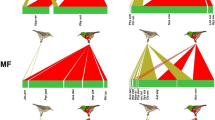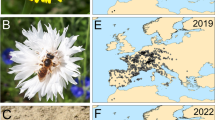Abstract
Theory on microtine mating systems predicts that male spacing behavior will be related to female spatial and temporal distribution. However, data from a natural population of field voles, Microtus agrestis, indicated a potential influence of female density on the spacing behavior of males. Therefore, I experimentally investigated the relative importance of female density and female spatial distribution for the spacing behavior of males in M. agrestis. Males were radio-tracked in enclosed natural habitats in which females at different densities were placed in two different spatial arrangements: clumped versus even distribution. Female density was the main factor determining male spacing behavior. At the high female density males had smaller home ranges and moved shorter distances between radio-tracking recordings. Also, home ranges were more exclusive at high female density. However, since there was a significant positive correlation between home range size and range overlap, range exclusiveness seemed to be influenced by female density indirectly through the effect of range size. Female spatial distribution, on the other hand, had no influence on male home range exclusiveness.
Similar content being viewed by others

References
Agrell J (1995) A shift in female social organization independent of relatedness: an experimental study on the field vole (Microtus agrestis). Behav Ecol, 6:182–191
Alcock RV, Jones CE, Buchmann SL (1977) Male nesting strategies in the bee, Centris pallida Fox (Anthophoridae: Hymenoptera). Am Nat 111:145–155
Bujalska G (1985) Regulation of female maturation in Clethrionomys spp., with special reference to an island population of C. glareolus. Ann Zool Fenn 22:385–392
Clutton-Brock TH (1989) Mammalian mating systems. Proc R Soc Lond B 236:339–372
Darwin C (1871) The descent of man, and selection in relation to sex. John Murray, London
Davies NB (1991) Mating systems. In: Krebs JR, Davies NB (eds) Behavioural ecology, an evolutionary approach, 3rd edn. Blackwell, Oxford, pp 263–294
Dixon KR, Chapman JA (1980) Harmonic mean measures of animal activity areas. Ecology 61:1040–1044
Emlen ST, Oring LW (1977) Ecology, sexual selection, and the evolution of mating systems. Science 197:215–223
Erlinge S, Hoogenboom I, Agrell J, Nelson J, Sandell M (1990) Density-related home-range size and overlap in adult field voles (Microtus agrestis) in southern Sweden. J Mammal 71:597–603
Gosling LM (1986) The evolution of mating strategies in male antelopes. In: Rubenstein DI, Wrangham RW (eds) Ecological aspects of social evolution: birds and mammals. Princeton University Press, Princeton, pp 244–281
Hurlbert SH (1984) Pseudoreplication and the design of ecological experiments. Ecol Monogr 54:187–211
Ims RA (1987) Male spacing systems in microtine rodents. Am Nat 130:475–484
Ims RA (1988) Spatially clumping of sexually receptive females induces space sharing among male voles. Nature 335:541–543
Jeppsson B (1990) Effects of density and resources on the social system of water voles. In: Tamarin RH, Ostfeld RS, Pugh SR, Bujalska G (eds) Social systems and population cycles in voles. Birkhduser, Basel, pp 213–226
Kleiman DG (1977) Monogamy in mammals. Q Rev Biol 52: 39–69
Lambin X, Krebs CJ (1991) Spatial organization and mating system of Microtus townsendii. Behav Ecol Sociobiol 28: 353–363
Madison DM (1980) Space use and social structure in meadow voles, Microtus pennsylvanicus. Behav Ecol Sociobiol 7:65–71
Madison DM, McShea WJ (1987) Seasonal changes in reproductive tolerance, spacing and social organization in meadow voles: a microtine model. Am Zool 27:899–908
Mihok S (1979) Behavioral structure and demography of subarctic Clethrionomys gapperi and Peromyscus maniculatus. Can J Zool 57:1520–1535
Myllymdki A (1977) Intraspecific competition and home range dynamics in the field vole Microtus agrestis. Oikos 29:553–569
Nelson J (1995) Intrasexual competition and spacing behaviour in male field voles, Microtus agrestis, under constant female density and spatial distribution. Oikos 73:9–14
Ostfeld RS (1985) Limiting resources and territoriality in microtine rodents. Am Nat 126:1–15
Ostfeld RS (1986) Territoriality and mating system of California voles. J Anim Ecol 55:691–706
Ostfeld RS (1990) The ecology of territoriality in small mammals. Trend Ecol Evol 5:411–415
Ostfeld RS, Pugh SR, Seamon JO, Tamarin RH (1988) Space use and reproductive success in a population of meadow voles. J Anim Ecol 57:385–394
Sandell M, Liberg O (1992) Roamers and stayers: a model on male tactics and mating system. Am Nat 139:177–189
Sandell M, Agrell J, Erlinge S, Nelson J (1991) Adult philopatry and dispersal in the field vole Microtus agrestis. Oecol 86:153–158
Trivers RL (1972) Parental investment and sexual selection. In: Campbell B (ed) Sexual selection and the descent of man, 1871–1971. Aldine, Chicago, pp 136–179
Viitala J (1977) Social organization in cyclic subarctic populations of the voles Clethrionomys rufocanus (Sund.) and Microtus agrestis (L.). Ann Zool Fenn 14:53–93
Viitala J (1987) Social organization of Clethrionomys rutilus (Pall.) at Kilpisjärvi, Finnish Lapland. Ann Zool Fenn 24:267–273
Williams GC (1966) Natural selection, the cost of reproduction and a refinement of Lack's principle. Am Nat 100:687–690
Wolff JO (1980) Social organization of the taiga vole (Microtus xanthognathus). Biologist 62:34–45
Wolff JO, Lidicker WZ (1980) Population ecology of the taiga vole, Microtus xanthognathus, in interior Alaska. Can J Zool 58: 1800–1812
Wolff JO, Cicirello DM (1990) Mobility versus territoriality: alternative reproductive strategies in white-footed mice. Anim Behav 39:1222–1224
Ylönen H (1990) Phenotypic flexibility in the social organization of Clethrionomys. In: Tamarin RH, Ostfeld RS, Pugh SR, Bujalska G (eds) Social systems and population cycles in voles. Birkhäuser, Basel, pp 203–212
Author information
Authors and Affiliations
Additional information
Communicated by G. Wilkinson
Rights and permissions
About this article
Cite this article
Nelson, J. Determinants of male spacing behavior in microtines: an experimental manipulation of female spatial distribution and density. Behav Ecol Sociobiol 37, 217–223 (1995). https://doi.org/10.1007/BF00177400
Received:
Accepted:
Issue Date:
DOI: https://doi.org/10.1007/BF00177400



